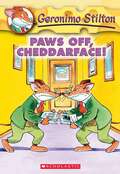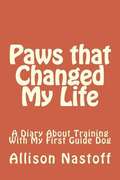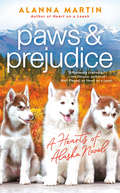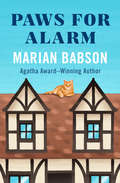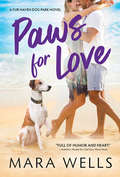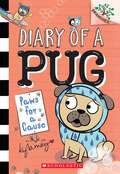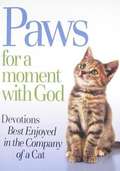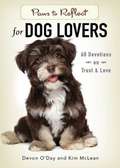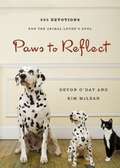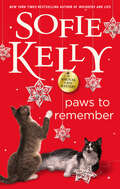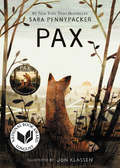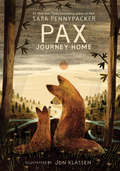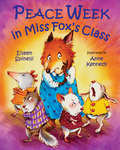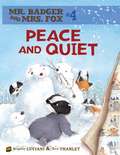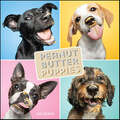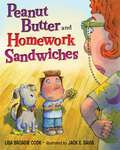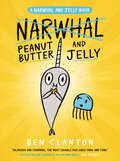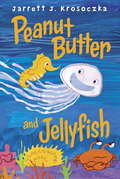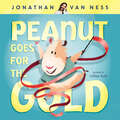- Table View
- List View
Paws Off, Cheddarface! (Geronimo Stilton Series #6)
by Geronimo Stilton Larry KeysEnter the world of Geronimo Stilton, where another funny adventure is always right around the corner. Each book is a fast-paced adventure with lively art and a unique format kids 7-10 will love. <p><p>Who Is Geronimo Stilton? That's me! I run a newspaper, but my true passion is writing tales of adventure. Here on Mouse Island, my books are all best-sellers! They are whisker-licking good tales, and that's a promise! <p><p>PAWS OFF, CHEDDARFACE! <p>It was the strangest thing... all across New Mouse City, rodents kept telling me I'd done things I had no memory of! I soon discovered why... there was a Geronimo look-alike out there, pretending to be me. He'd even fooled my sister Thea! And worst of all, he was trying to take over my newspaper. I had to find a way to strike back -- but how?
Paws That Changed My Life: A Diary About Training With My First Guide Dog
by Allison NastoffThis book is a diary, adapted from my blog on LiveJournal, in which I chronicle the preparation and training for my first service dog through an in-home training program.
Paws and Prejudice (Hearts of Alaska #2)
by Alanna MartinIt's up to a trio of adorable rescue huskies to make two lonely hearts in a coastal Alaskan town realize that true love is worth too much to turn tail and run.Glaciers have nothing on Kelsey Porter when she decides to freeze someone out. After getting burned once, she's not about to let it happen again. And right now all that icy contempt is focused on one annoyingly attractive and entitled interloper: Ian Roth. Not only is he looking to take advantage of her quaint, coastal community, tainting the small-town charm of Helen, Alaska, but he has committed the one crime she can never forgive--he doesn't like her dogs.Unlike what Kelsey believes, Ian loves Helen's charms as much as she does. That's partly why he's determined to open a brewery there, and he's not about to let anything or anyone stop his dream from coming true. But he didn't count on the beautiful, prickly woman getting under his skin. Or having to be within hand-biting proximity of her three huge huskies.When Kelsey's family conscripts her into helping Ian get his brewery off the ground, she finds herself caught between a rock and a hard . . . muscular . . . man who has a fear of dogs. But the longer they work together, the more she can feel herself begin to thaw. Now she'll have to choose: let sleeping dogs lie to protect her heart, or mush head-on toward love.
Paws for Alarm (Dead Letter Mysteries Ser.)
by Marian BabsonCan this housecat prevent a homicide? An &“inventive&” mystery from the Agatha Award–winning author (Chicago Tribune). The Harpers have traded their New England home for a cottage in the original England—just for the summer. Their cozy new house even comes complete with Esmond, a timid marmalade cat. But the peaceful village starts to feel less welcoming when an attempt is made on Mr. Harper&’s life. Now, amid secrets and suspicions, they must sniff out the truth—with a little help from Esmond. Praise for Marian Babson &“What can a reviewer say about Marian Babson? If you haven&’t read at least one of her books, you have definitely missed the boat. She is consistently witty.&” —Mystery News
Paws for Love (Fur Haven Dog Park #3)
by Mara WellsBroken hearts—man, woman, and dog—get a second chance at love, healing, and happiness under the warm Miami Beach sun in this endearing contemporary romance...Danielle Morrow works tirelessly for a greyhound rescue helping retired racing dogs find their forever homes. She guards her heart as vigilantly as her two adopted greyhounds guard her. One heartbreak per lifetime is enough for any woman, and no one she's met since her high school boyfriend dumped her to join the military has ever tempted her enough to risk love again.Knox Donovan expected to be career military, but an injury and an honorable discharge leave him uncertain of his future. When his brothers ask him to come back to Miami Beach to help with their new condo conversion, he has no intention of staying on in the city that has so many bad memories for him.Knox is reminded that not all his memories are bad when he sees Danielle again at the grand opening of the new Fur Haven Dog Park. Fifteen years haven't softened the pain of their breakup. But Knox is different now, more hard-edged and suspicious, and when he bonds with the retired racing greyhound, Sarge, Danielle's cool reserve begins to melt. Sarge needs special care after the injuries that ended his racing career, and it's not long before Danielle realizes that Knox does too—they can give each other one more chance at the love and friendship they deserve. But can Danielle trust her heart to the only man who's ever broken it?Snuggle up with your best dog companion and get reading: This lighthearted romance includes a veteran who could use a four-legged best friend, a second chance with a high school sweetheart, and a determined heroine who isn't going to let the man of her dreams get away again.
Paws for a Cause: A Branches Book (Diary of a Pug #3)
by Kyla MayThe third book in a sweet and funny Branches series about a pug and his human, told from the pug's POV!Pick a book. Grow a reader!This series is part of Scholastic's early chapter book line, Branches, aimed at newly independent readers. With easy-to-read text, high-interest content, fast-paced plots, and illustrations on every page, these books will boost reading confidence and stamina. Branches books help readers grow!When the local animal shelter can't afford new toys, it's up to Bub and his human, Bella, to save the day. But how could they possibly raise the money? A pet wash, of course! Fun and high jinks abound as Bella and Bub learn that running a pet wash is harder and wetter than it looks.With full-color artwork throughout, this funny and charming diary-format early chapter book is perfect for anyone who believes a furry pal is the best kind of friend.
Paws for a Moment with God: Devotions Best Enjoyed in the Company of a Cat
by Patricia Mitchell"May this little book of reflections, famous quotations, and classic and contemporary poems make you smile as you read Bible-centered devotions, each one drawn from the attitude, antics, and presence of our beloved cats... This book of reflections and devotionals will inspire and encourage... and if one of the blessings you have been given is the companionship of a wonderful cat, then cozy in together and spend a moment with God."
Paws to Reflect for Dog Lovers: 60 Devotions on Trust & Love
by Devon O'Day Kim McLean Devon O'DaySometimes human communication falls short in conveying spiritual truth. Sometimes God speaks through whatever means He chooses—and often he chooses our four-legged friends.Paws to Reflect for Dog Lovers offers 60 reflections for those who seek to grow spiritually by observing the unconditional love and devotion of our pups. This devotional offers a mix of humorous and heart-warming lessons in creative chapters such as these: You Can’t Judge a Cocker by Its Spaniel Footprints on the Pink Couch Growling for Grace The Hound of Heaven Cleanliness is Next to ImpossibleAs we stand in awe of humble animal hearts, we can learn important life lessons about overcoming mistakes, loving without judgment, persevering with wisdom and grace, resting in the arms of the One who loves us, and more.
Paws to Reflect: 365 Daily Devotions for the Animal Lovers Soul
by Devon O'Day Kim McLeanSometimes human communication falls short in conveying spiritual truth. God speaks through whatever means He chooses and often he chooses animals. Dogs teach unconditional love. The purr of a kitten can bring peace. Horses show us how to harness our strength with grace. Paws to Reflect offers gentle daily reflections for those who seek to grow spiritually by observing the animal kingdom and all the lessons it teaches.
Paws to Remember (Magical Cats #15)
by Sofie KellyLibrarian Kathleen Paulson and her enchanted felines get involved in a cold case that is putting people in very hot water in the newest installment of this New York Times bestselling series.When a water leak repair results in a body being found behind the walls of the store run by the artists&’ co-op that Kathleen's friend, Maggie, is part of everyone is completely mystified as to whose body it is and who hid it there. But as the dust settles, her boyfriend, Detective Marcus Gordon, begins to suspect the body could belong to a young woman who disappeared more than thirty years ago. When a friend with a connection to the young woman asks Kathleen to look into the circumstances around the disappearance, she and her cats—who have special feline talent for catching felons—find themselves digging up secrets that at least one person in Mayville Heights would much prefer stay buried.
Paws: This Book Will Help You Take a Break
by Ally FrancisCats have mastered the art of chilling out and, with a little help from this book, now you can too! Turn to this collection of care-free kitties for a dose of relaxation and inspiration. It’s the purr-fect way to press ‘paws’ and enjoy a few moments of peace and quiet.
Paws: This Book Will Help You Take a Break
by Ally FrancisCats have mastered the art of chilling out and, with a little help from this book, now you can too! Turn to this collection of care-free kitties for a dose of relaxation and inspiration. It’s the purr-fect way to press ‘paws’ and enjoy a few moments of peace and quiet.
Pax (Pax)
by Sara Pennypacker Jon Klassen<P>From bestselling and award-winning author Sara Pennypacker comes a beautifully wrought, utterly compelling novel about the powerful relationship between a boy and his fox. Pax is destined to become a classic, beloved for generations to come. <P>Pax and Peter have been inseparable ever since Peter rescued him as a kit. But one day, the unimaginable happens: Peter's dad enlists in the military and makes him return the fox to the wild. At his grandfather's house, three hundred miles away from home, Peter knows he isn't where he should be--with Pax. He strikes out on his own despite the encroaching war, spurred by love, loyalty, and grief, to be reunited with his fox . <P>Meanwhile Pax, steadfastly waiting for his boy, embarks on adventures and discoveries of his own. . . . <P><b>A New York Times Bestseller</b>
Pax, Journey Home (Pax)
by Sara PennypackerFrom bestselling and award-winning author Sara Pennypacker comes the long-awaited sequel to Pax; this is a gorgeously crafted, utterly compelling novel about chosen families and the healing power of love. <P><P> It’s been a year since Peter and his pet fox, Pax, have seen each other. Once inseparable, they now lead very different lives. <P><P> Pax and his mate, Bristle, have welcomed a litter of kits they must protect in a dangerous world. Meanwhile Peter—newly orphaned after the war, racked with guilt and loneliness—leaves his adopted home with Vola to join the Water Warriors, a group of people determined to heal the land from the scars of the war. <P><P> When one of Pax's kits falls desperately ill, he turns to the one human he knows he can trust. And no matter how hard Peter tries to harden his broken heart, love keeps finding a way in. Now both boy and fox find themselves on journeys toward home, healing—and each other, once again. <P><P> As he did for Pax, Jon Klassen, New York Times bestseller, Caldecott medalist, and two-time Caldecott Honoree, has created stunning jacket and interior illustrations. <P><P><b>A New York Times Best Seller</b>
Pea Soup Fog
by Constance SmithA small village on the rocky coast of Maine one day finds itself shrouded in thick fog. The shivering villagers do not listen to the advice of a small girl and instead turn to the ageless baker, butcher, and candle maker for thier help in riding them of the fog. Only after the three have had no success in getting rid of the fog do the villagers listen to the little girl. This story underscores the importance of community and the joys of finding answers in the most unlikely places and forms.
Peace Week in Miss Fox's Class
by Eileen Spinelli Anne KennedyMiss Fox is tired of hearing her young students quarrel. So she announces Peace Week--no more squabbling for one whole week! The children chime in with their own rules: no fighting, don't say mean things, and help others. Throughout the week each of the little animals gets a chance to practice this new behavior. When Polecat teases Bunny for wearing a bright yellow sweater, instead of poking fun back at Polecat, Bunny admires his sweater. Soon, to their surprise, the animals are finding that it's easy to help others, take turns, and say nice things, even when someone is grumpy to them. Wouldn't it be nice, Squirrel says, if every week could be Peace Week?
Peace and Quiet (Fountas & Pinnell LLI Blue)
by Brigitte Luciani Eve Tharlet Carol BurrellCan this family keep the peace when they're cooped up together underground? <P><P> The days are getting colder. The badgers' bellies are getting rounder, and the foxes' fur is growing longer. That can only mean one thing: winter is coming! Ginger wants to sing and play and hunt in the snow. She wishes her badger brother, Grub, would join her, but he is busy taking daylong naps. She needs a perfect plan to make the whole family happy. But what do you do with a badger who only wants peace and quiet?
Peaceful Piggy Yoga
by Kerry Lee MacleanWho loves yoga? Everyone from ballerinas to football players to moms and dads. Babies do yoga positions without even knowing it! From the author and illustrator of Peaceful Piggy Meditation, this fun and informative picture book guide shows kids--and piggies!--in classic yoga poses, complete with instructions. Kerry Lee MacLean brings her experience as a yoga instructor and children's meditation therapist to this unique guide, along with the bright, amusing piggy paintings that have become her trademark.
Peanut
by Linas AlsenasPOOR MILDRED IS VERY LONELY--UNTIL SHE GETS A NEW PET. She names him Peanut, and decides he's a dog. There's a problem, though: Peanut isn't like all the other dogs. He doesn't roll over. He never fetches. And his nose is much, much bigger than that of a poodle, terrier, or pug. Perhaps there's more to Peanut than meets Mildred's eye. ...
Peanut Butter Puppies
by Greg MurrayRescue-dog advocate and professional photographer Greg Murray has followed up on the fan favorite Peanut Butter Dogs with an even more irresistible theme: Peanut Butter Puppies. These adorable portraits of rescued dogs, captured in studio with colorful backgrounds and in delightfully amusing detail, will tug at your heartstrings. Prepare to swoon over Wallaby, the seven-month-old heeler; Archie, the eight-month-old Chihuahua; Fiona Wigglesworth, the eight-month-old Boston terrier; Zoey, the nine-month-old mastiff mix, and so many more! Each one-of-a-kind portrait is sure to make your day. Names, ages, and breed/mix accompany each portrait.
Peanut Butter and Homework Sandwiches
by Lisa Broadie CookMartin MacGregor is having one rotten week! First, his substitute teacher, Mrs. Payne, gives out mountains of homework. And when Martin's dog literally eats his homework, little does he know it's only the beginning of his troubles. Martin's homework ends up in the washing machine, goes to kindergarten with his little sister, and blows onto the roof of the school. Martin just can't catch a break! But with some creativity and a positive attitude, Martin finds his own way to turn homework into fun-and turn it in on time! New York Times bestselling illustrator Jack E. Davis's vibrant and detailed artwork gives life to a funny, lively story that is sure to resonate with anyone who has ever felt what it's like to show up unprepared- even when it's not your fault.
Peanut Butter and Jelly (A Narwhal and Jelly Book #3)
by Ben ClantonA New York Times Bestselling series&“Hilarious and charming. The most lovable duo since Frog and Toad.&” —NYT-bestselling creator of the Dog Man and Captain Underpants series, Dav PilkeyNarwhal's obsession with a new favorite food leads the duo into hijinks and hilarity in the third book of this all-star early graphic novel series! Narwhal and Jelly are back and Narwhal has a new obsession . . . peanut butter! Narwhal is so obsessed they even want to change their name to . . . that's right . . . Peanut Butter! Ever-sensible Jelly isn't so sure that's the best idea, but is all for Narwhal trying new things (instead of just eating waffles all the time, no matter how delicious waffles are). In this third book, Narwhal and Jelly star in three new stories about trying new things, favorite foods and accepting who we are. Always funny and never didactic, this underwater duo charms again through their powerful combination of positive thinking, imagination and joyfulness.
Peanut Butter and Jelly (A Narwhal and Jelly Book)
by Ben Clanton&“The most lovable duo since Frog and Toad.&” —Dav Pilkey, bestselling creator of Dog Man and Captain Underpants The funny and adorable New York Times bestselling kids graphic novel series starring happy-go-lucky, waffle-loving Narwhal and somewhat cynical sidekick, Jelly. In this hilarious 3rd book, Narwhal's obsession with a new favorite food leads the duo into hijinks and hilarity. Includes bonus fun facts!Narwhal and Jelly are back and Narwhal has a new obsession . . . peanut butter! Narwhal is so obsessed they even want to change their name to . . . that's right . . . Peanut Butter! Ever-sensible Jelly isn't so sure that's the best idea, but is all for Narwhal trying new things (instead of just eating waffles all the time, no matter how delicious waffles are).In this third book, Narwhal and Jelly star in three new stories about trying new things, favorite foods and accepting who we are. Always funny and never didactic, this underwater duo charms again through their powerful combination of positive thinking, imagination and joyfulness.
Peanut Butter and Jellyfish
by Jarrett J. KrosoczkaPeanut Butter and Jellyfish are the best of friends. They swim up. They swim down. They swim all around. Except near Crabby, who never has anything nice to say to them. "You two swim like humans" is the least of his insults. Then one day Crabby is caught in a lobster trap and needs their help! Should they help him? It's Peanut Butter and Jellyfish to the rescue! Crabby might be afraid of heights . . . but will he be brave enough to apologize?This charming story about friendship, kindness, and building social skills is perfect for preschoolers and kindergarteners.
Peanut Goes for the Gold
by Jonathan Van NessJonathan Van Ness, the star of Netflix’s hit show Queer Eye, brings his signature humor and positivity to his empowering first picture book, inspiring readers of all ages to love being exactly who they are. Peanut Goes for the Gold is a charming, funny, and heartfelt picture book that follows the adventures of Peanut, a gender nonbinary guinea pig who does everything with their own personal flare.Peanut just has their own unique way of doing things. Whether it’s cartwheeling during basketball practice or cutting their own hair, this little guinea pig puts their own special twist on life. So when Peanut decides to be a rhythmic gymnast, they come up with a routine that they know is absolutely perfect, because it is absolutely, one hundred percent Peanut. This upbeat and hilarious picture book, inspired by Jonathan’s own childhood guinea pig, encourages children to not just be themselves—but to boldly and unapologetically love being themselves. Jonathan Van Ness brings his signature message of warmth, positivity, and self-love to this boldly original picture book that celebrates the joys of being true to yourself and the magic that comes from following your dreams.
